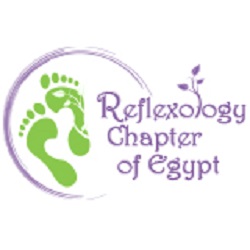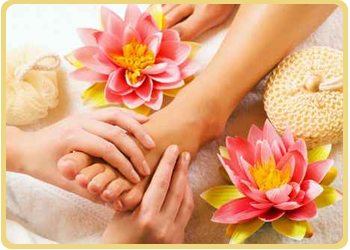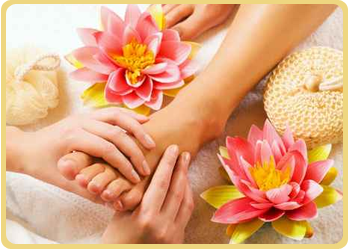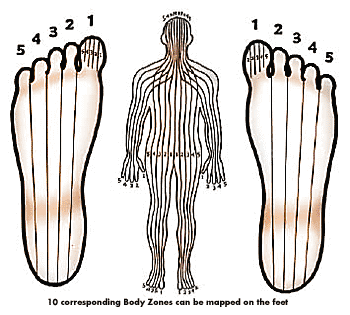| This article brought you us by the Universal College of Reflexology
How Does Reflexology Work?
Reflexology, in common with other complementary therapies, is trying to gain scientific credibility in order to be accepted by the mainstream medical profession. Part of this process involves explaining how Reflexology works. Listed below are some of the common theories of how Reflexology works. Many of the theories are not exclusive to Reflexology, and can be applied to a number of other therapies.
The Nerve Impulse Theory
When pressure is applied to the foot, or any other organ in the body, afferent neurons conduct the message to ganglia or groups of neurons outside the spinal cord. Normally, messages pass
 Points of Reflexology 1. Pituitary 2. Neck 3. Side of head and Brain 4. Top of head and Brain 5. Sinus 6. Eye 7. Eustachian tube 8. Ear 9. Thyroid 10. Lung 11. Heart 12. Solar Plexus 13. Liver 14. Spleen 15. Stomach and Pancreas 16. Small Intestine 17. Colon 18. Bladder 19. Ureter tube 20. Kidney 21. Adrenal 22. Shoulder 23. Ovary/testes 24. Sciatic Nerve (Photo credit: Wikipedia) from the ganglia to the spinal cord then up to the brain for interpretation. Motor nerves than carry responses down the spinal cord, out to the ganglia then on to the appropriate muscles for activity.
The electrical impulse theory says that for a reason, as yet unexplained, messages from the feet reaching the ganglia connect up with the messages going to muscles, so that working the feet has direct action on bodily organs. This explains why Reflexology zones are vertical, with pressure on one side of the foot affecting organs on the same side of the body. The theory can also be used to explain how Reflexology benefits people with paralysis due to severing of the spinal cord.
The electrical impulse theory has much in common with the reflex arc, a well-known physiological phenomenon. Examples of involuntary reflexes include blinking, pupil contraction to light, knee and ankle jerks. The doctor tapping the bottom of the knee with a rubber hammer so that the leg shoots up is checking that the reflex arc is working, as an indication of proper neurological functioning. The reflex arc relies on nerve synapses or connections between sensory nerves and motor nerves in the spinal cord so that the activity takes place a split second before the brain is told about it, or can initiate it itself.
Gate Control Theory
A theory of pain is the gate-control theory. This theory says that pain receptors in the spinal cord regulating the amount of pain that can pass up to the brain. Once all the receptors are full, the ‘gate’ shuts, stopping further pain messages going up to the brain. This limits the amount of pain we feel.
The Placebo Effect
Many studies have indicated that patients have benefited from medication and surgery when they have in fact been receiving a placebo. Likewise, patients have suffered side effects from inert substances taken as a placebo. Trust in the therapist is an essential component of the effect as is the therapists’ confidence in what they are doing. Personality type is no indication as to reaction to a placebo. Perhaps the reason that Reflexology works is because of a placebo effect and the type of treatment is not as important as the relationship between therapist and client.
Impeded and Unimpeded Energy Flow Theory
This theory suggests that the ground pulsates with positive and negative electrical energy charges that are picked up by positive and negative receptors on the feet. The energy receptors in the feet are a part of the nervous system. In the healthy person, the charges and energy from the earth pass freely into the nervous system.
If the positive and negative charges in the feet are not in contact with the earth, due to congestion in the feet or particles impeding passage, they cannot pick up the earth charges as effectively and energy flow is impeded.
Reflexology can unblock the pathways allowing the electrical terminals in the feet to touch the ground again so that energy can flow freely
 Reflexology Rocks (Photo credit: teddy-rised) again.
It is now thought that modern systems of pain relief e.g. TENS machines, work by mildly stimulating the nerve pathways. All the receptors are filled, the gates shut and severe pain stimuli cannot be passed up the spinal cord to the brain. It has been hypothesized that Reflexology works in the same way as a TENS machine.
The Relaxation Effect
It is known that much illness originates from stress and tension in the body. It can be theorized that anything that relieves stress and tension and promotes deep relaxation will enable systems and organs in the body to work much more effectively. This theory suggest that Reflexology is very restful and relaxing, and therefore alleviates and helps prevent illness.
Subtle Energy/Zone/Meridian Theories
Subtle energy is a life force that animates the physical body. It is absorbed from the universe in general and from the air around us in particular when we breathe, touch or eat and it can be channeled into the body by healers. Zone theories have been around for several centuries, meridian theories for a lot longer. Both believe that subtle energy flows through the body in channels
 Reflexology demostration at Spearwood Library (Photo credit: Cockburn Libraries) and that disruption to this energy flow results in ill health. Energy may stagnate, become blocked, or speed up. Blockages may be caused by stress, pain, injury and trauma or by a lack of exercise, amongst other reasons. The role of the therapist is to work on the areas of disrupted energy to restore a normal flow. See Zone Theory article for more details
The Holographic Principle
At a highly symbolic level, the holographic principle that “every piece contains the whole” can be seen in the cellular structure of all living bodies. Scientific discoveries in the world of cellular biology, have demonstrated that every cell contains a copy of the master DNA blueprint, with enough information to make an entire human body from scratch. The fact that every cell within the human body contains the information to create an entire duplicate body mirrors the holographic principle (see article “Understanding the Holographic Principle” ) whereby every piece contains the information of the whole.
This holographic principle when extended to the human body as a whole and Reflexology in particular may be applied like this. Parts of the body such as the hands, ears, and feet when stimulated affect the body as a whole. In that each of these parts carries the picture of the whole body, and so homeostasis or a dynamic state of balance can be achieved by stimulating the
 English: Hand reflexology is a “pressure therapy” and involves applying focused pressure to certain known reflex points located in the hand to cure or prevent disease. (Photo credit: Wikipedia) reflexes in any one of these parts.
Electro-Magnetic Theories of Healing
A number of slightly different theories have much in common. It is known that all matter, including human cells, vibrate at certain rates. The brain in particular has recognized waves that can be detected on Electroencephalograms (EEGs). Alpha waves (8 – 13Hz cycles per second) are indicative of deep relaxation. It is also known that the earth is vibrating at a regular rate, in a frequency band known as Schumann Resonance, and that this rate is similar to that of Alpha waves. It can be postulated that the person whose cells vibrate at an alpha rhythm is in harmony with their surrounding and therefore likely to be in a positive state of health.
It is theorized that the brain is the link between the earth’s vibrations and our bodily vibrations. Electromagnetic messages are created in the brain as it oscillates between positive and negative polarities. It is also known that the human body contains iron (in red blood cells), dissolved electrolytes (sodium, chloride and potassium bicarbonate, in blood plasma), proteins (which act as semiconductors) and water, and therefore generates a bio-magnetic field. To send rapid messages the brain works like a radio transmitter/receiver, sending and receiving electro-magnetic signals directly to and from our body cells to regulate their vibrational frequency . The brain also uses the much slower nervous and circulatory systems to pass chemical and electro-magnetic messages to and from cells to regulate vibrational frequency.
Problems can arise in two ways. Firstly, under certain conditions the electrical messages from the brain can become blocked or distorted like a radio not quite tuned into a station. With damage e.g. caused by stress, the pairs of electrons spin in the same rather than in opposite directions, distorting the signal and causing cells to malfunction. Secondly, cells can vibrate at less than optimum frequency due to injury, emotional trauma or a decreased magnetic field. Degenerative diseases, memory loss and conditions such as ME have all been associated with magnetic field
 64 (Photo credit: barnism) deficiency.
Healing focuses on these two areas. Simultaneous EEG recordings (measuring brain electrical activity) often show that a client’s EEG pattern comes into synchrony with those of the healer during a healing session indicating sympathetic resonance is taking place. Studies have shown that the brain waves generated by healers are often Alpha waves. It is theorized that the healer, having tuned the client into the same wave length as themselves, can retune the messages to the correct frequency, or replace missing signals with their own signals restoring the Alpha wave link between brain and cells. In developing a relaxed alpha state prior to healing, the healer also taps into the earth’s vibrational energy to channel healing from outside through to the cells.
Healers monitored by electrometers have generated fluctuating surges of low frequency body potential of between 0.3 Hz and 30 Hz, with most activity in the range 7Hz. In some healers, up to 60 Hz of potential difference was found between the head/hands and the feet. In electrical terms the healer’s body becomes a LF bio-electric dipole antenna. It is known that 2 Hz can regenerate nerve tissue, 7 Hz can trigger bone growth, 10 Hz can heal ligaments whilst 15-72 Hz can decrease skin necrosis and generate capillary formation.
Magnetometers have measured palmar biomagnetic fields 1000 times greater than those of the heart and a million times greater than those of the brain. In
 63 (Photo credit: barnism) everyday life, palmer bio-magnetism is borderline detectability. The theory can explain why healers often feel tingling in their hands during a treatment. Areas of heat or blockage that healers sometimes say that they can feel on the body may be electrical resistance at the cellular or tissue level. It is also theorized that the healer’s sweeping or scanning of the body during healing could re-magnetize the blood and stimulate the bio-magnetic fields of the body. The circulatory system can then transport healing energy around the body in blood and plasma to restore correct vibrations.
Evidence in support of a healing energy theory have included accelerated tissue healing and bone repair beyond chance probability. Experiments with nerve cells in petri dishes have shown that energy generated by healers can cause impulses to travel along these nerve cells and jump between the synapses or gaps between cells from one nerve to another. Research has shown that brain cells contain millions of crystals suggesting that the brain acts like a radio transmitter/receiver.
Endorphin Release Theories
Endorphins are the body’s natural opiates or painkillers, with actions similar to that of morphine. These are stimulated by pain, and serve to reduce the amount of pain that we feel by inhibiting
 English: Foot reflexology is a “pressure therapy” and involves applying focused pressure to certain known reflex points located in the foot to cure or prevent disease. (Photo credit: Wikipedia) the activity of a neurotransmitter called substance P, that is thought to transmit pain. It is theorized that a Reflexology treatment stimulates the release of endorphins to help ease pain and to give the body the same natural elevation in mood as strong painkillers.
Facilitation Theory
This school of thought believes that the patient does their own healing when and if they are ready, regardless of the therapist or the type of therapy. The role of the therapist is to facilitate the process.
The Feet as a ‘U’ Bend Theory
In a plumbing system, the ‘U’ bend traps all the debris that passes through the sink, toilet or wash basin. With time, unless proprietary cleaners are used, the bend becomes clogged and waste water cannot flow away properly. The feet are the furthest point in the circulatory system from the heart. They are also the part of the body where the effect of gravity is greatest, and are in effect, the “U’ bend of the body. It is theorized that calcium, uric acid and lymphatic deposits in the blood accumulate in the feet interfering with the normal circulation of blood and lymph. Reflexology breaks up and moves these deposits, thus improving blood and lymph circulation.
Conclusion
Maybe Reflexology works because it is a combination of all of the above. At this point in time we just don’t know. Whilst it is important for the credibility of Reflexology to explain how it works, it may be many years before the scientific capability is available to test some of the theories, if at all. The effect of Reflexology may be due to an isolated factor, or due to a combination of factors. The important point to bear in mind in the meantime, is that regardless of how and why it works, Reflexology does work and brings benefit to thousand of people.
|





















 Although reflexology is not used to diagnose or cure health disorders, millions of people around the world use it to complement other treatments when addressing conditions like
Although reflexology is not used to diagnose or cure health disorders, millions of people around the world use it to complement other treatments when addressing conditions like  The left foot corresponds to the left side of the body and all organs, valves, etc. found there.
The left foot corresponds to the left side of the body and all organs, valves, etc. found there. Reflexology and acupressure are both “reflex” therapies in that they work with points on one part of the body to affect other parts of the body. While reflexology uses reflexes that are in an orderly arrangement resembling a shape of the
Reflexology and acupressure are both “reflex” therapies in that they work with points on one part of the body to affect other parts of the body. While reflexology uses reflexes that are in an orderly arrangement resembling a shape of the  2330 BC along with other medical procedures.
2330 BC along with other medical procedures.












